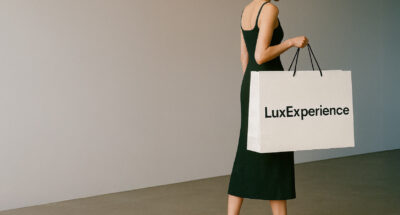
Why AI ethics is now a competitive advantage
IMD’s 2025 AI Maturity Index shows how the most advanced companies have embedded ethics frameworks as part of their cross-functional strategies....

by Stéphane J. G. Girod, David Branch Published June 4, 2025 in Strategy • 8 min read
“I think e-commerce is dead,” said Thomas Davis, Head of Customer Experience and Digital Transformation at KIKO MILANO, in a recent IMD Luxury 2050 Forum C-Suite Talk that brought together senior leaders from Estée Lauder, KIKO MILANO, and Trinity Asia to explore what’s next for digital commerce in luxury. Their verdict was clear: the traditional e-commerce playbook no longer works.
“For the last 20 years, businesses have been building digital experiences that center on the conversion funnel: homepage to product listing page to product detail page to cart, and then to checkout. There has been no innovation in this flow for over a decade. This is concerning as the Gen A shoppers of tomorrow are going to expect, if not demand, something drastically different,” continued Davis.
In a much tougher economic environment, luxury retail is facing a reality check and needs to become more resilient. Sales are falling, uncertainty is rising, and consumers are becoming more selective and demanding. With global sales of luxury goods projected to shrink by up to 5% this year, the industry is under mounting pressure to rethink not just what it sells, but how, and where, it sells it.

According to Davis, “As you get into the luxury space the digital touch points are just a set of services, and it’s services that help a customer explore, discover, be inspired about what he or she may want in the future, and you have to be understanding (of) that relationship with the customers. Of course, one of those services being offered is ecommerce, but there is so much more needed than just a shopping cart for this type of customer.”
The old model, born in the 1990s, transactional, impersonal, and disconnected from brand identity, no longer satisfies digitally fluent, experience-hungry consumers. What’s emerging instead is more human and high-touch: a new era of direct, data-powered, emotionally intelligent commerce.

“Unlike physical stores, they aren’t constrained by space and allow for deeper engagement with customers.”
“Even in a physical-first luxury world, hyper-personalization is now a defining digital opportunity,” said Daniel Mahler, Executive Vice President of Strategy and Transformation at Estée Lauder. “The ability to know what your consumer has done once (before),understand her or him to the nittiest detail and then serve her and be in a dialogue with her… It’s an enormous opportunity that is enabled by digital.”
Mahler also pointed to the expansive potential of owned digital platforms, brand.com websites that allow storytelling to go further beyond the confines of physical retail. Unlike physical stores, they aren’t constrained by space and allow for deeper engagement with customers. “If you make it interesting, it’s much more than an e-commerce transaction platform,” he said.
Together, hyper-personalization and an unlimited storytelling space represent powerful tools for luxury brand building. “They are amazing and should be leveraged,” he said.

Adding another component to the mix is the need for unified experiences, which blend physical and digital, marketing and interaction, and data and emotion.
Davis believes unified commerce begins with truly recognizing the customer. He’s working to transform KIKO from a brand that merely broadcasts messages to one that engages in meaningful two-way conversations, focusing on knowing customers deeply, personalizing experiences, and actively listening to their feedback.
“As we get into a much more fragmented world, which is not only retail or dotcom, but getting into branded retail, such as wholesalers or e-wholesalers, or even the grey market, understanding the data, capturing the data of our most loyal customers is very important.”
This shift is accelerating by changing digital behaviors. “For the next generation of customers between the ages of eight and 16, it’s going to be completely different by the time we get to 2030. The question is, do brands anticipate the change fast enough to manage that luxury experience in a democratized world?”
With younger, independent brands raising the bar for digital engagement, legacy players are under pressure to stay relevant across all channels.
If the digital experience is evolving, the physical presence is becoming indispensable.
“It is impossible to maintain a luxury brand’s equity with these beautiful digital ecosystems unless you also back it up with real physical experiences,” said Alexis Bonhomme, Founder and CEO at Trinity Asia.
Mahler agreed that digital alone is not enough. “For us to build a brand, we need to have a brand home,” he said. “If the brand is Darphin in Paris, an institute that you can visit, that exists as a physical space where people can take pictures. If you don’t have the physical backup, any digital world that you create around luxury will be shallow at some point and won’t survive.”
With younger, independent brands raising the bar for digital engagement, legacy players are under pressure to stay relevant across all channels. “We need to be as good as these indie brands in the way they engage, meaning socially,” said Mahler. “And we need to be on social media, and we need to be as good as they are on the e-commerce side of things, meaning we need to be present on all the platforms.”

Integration across channels isn’t just a strategy; it’s the expectation. And achieving that level is no small task. It requires building systems that not only respond to shifting consumer expectations but do so authentically across markets, languages, and cultures.
“Some of these purchases are the lifelong dreams of people,” said Davis. “You’re having a conversation that’s running for the most part, except for the luxury few, for months, years, or even decades.”
Modern customer engagement needs to go beyond e-commerce to provide a service-oriented experience, he added. This includes helping customers envision their future journey with the product through tools like AR/VR, and showrooms where they can try on and test purchases. Digital touchpoints should support the customer seamlessly through every step of this journey, regardless of how long it takes, he said.
His firm helps global luxury brands navigate the Chinese market through localized digital strategies
Nowhere are these shifts more visible than in China. Once the growth engine of the global luxury sector, the Chinese market has entered a more cautious, complex phase. Consumers are still spending, but with sharper expectations and closer scrutiny of where brands stand on issues of origin, value, and meaning.
Bonhomme is witnessing two main challenges from tariffs: first, margin compression is forcing companies to adjust sourcing, and second, and more critically, a psychological impact that is significantly undermining consumer confidence beyond the direct financial costs.
His firm helps global luxury brands navigate the Chinese market through localized digital strategies. What he’s seeing, he warned, is a widening gap between global brand narratives and local consumer sentiment.
“We are in a closed ecosystem,” he noted. “If we look at China and even Asia. It’s a very insular market. WeChat is in China. Kakao is in Korea. LINE is in Japan. It’s quite different from the Western world. Obviously, there is no perfect recipe, but so far, what we do see the most is that brands adapt their content based on the platform they are operating.”
To succeed, brands must go beyond translation and embrace cultural fluency. “A lot of content might still come from global when it comes to luxury fashion, but needs to be more localized when it comes to beauty or other categories,” said Bonhomme. “It’s quite painful sometimes, but yes, you need adaptation. You need localization.”
Tariffs and geopolitical shocks have forced a strategic pivot towards regional manufacturing and faster local delivery, particularly for global companies with significant US operations and broad international customer bases.
Behind the scenes, luxury brands are rethinking operations to support this evolving customer dynamic. Tariffs and geopolitical shocks have forced a strategic pivot towards regional manufacturing and faster local delivery, particularly for global companies with significant US operations and broad international customer bases. Today, where you manufacture matters just as much as what you sell.
At Estée Lauder, this shifting landscape has created momentum to accelerate existing regionalization plans. “It’s a big challenge for us,” acknowledged Mahler. “We do see an opportunity to accelerate our regionalization of our supply chain, to have a manufacturing footprint where we can change the location of where we make products as needed, as the geopolitical environment requires it.”
A key part of this effort is a new production facility in Japan, designed to serve local markets directly, and bypassing the need for US-based exports.
The death of e-commerce isn’t about going offline. It’s about building something better. Bonhomme underscored the need for control and consistency. “If brands can control the distribution, including digital distribution, they can control the image. And if you can control your image, you can control your pricing and ultimately your margins.”
Davis reiterated the importance of differentiation: “Department store businesses are littered with casualties in recent years, and abandoned storefronts are becoming commonplace in many metros… because when you have no differentiation, you can’t compete. And the same could be true for digital retailers as well.”
Mahler closed with a call for agility. “Instability or change is the new normal. We can no longer think that there’s a linear path. We need to think in scenarios and have our backup plan already in the drawer.”
To succeed in the next decade, luxury brands must shed outdated assumptions, deepen their digital strategy, and build experiences that are not just personal but indispensable.

Professor of Strategy and Organizational Innovation
Stéphane J.G. Girod is Professor of Strategy and Organizational Innovation at IMD. His research, teaching and consulting interests center around agility at the strategy, organizational and leadership levels in response to disruption. At IMD, he is also Program Director of Reinventing Luxury Lab and Program Co-Director of Leading Digital Execution.

Member of the ULI Europe Hotels, Destinations and Resorts Council and Co-founder and member of the Advisory Board of the IMD Luxury 2050 Forum.
David brings over 30 years of urban and resort development, distribution, marketing and sales experience with projects valued at over USD5billion. He served as Global Managing Director, Development Project Marketing & Sales at CHRISTIE’s International Real Estate, Vice-President of the EMEA business unit and member of the Executive Management Committee of playground, (part of the Intrawest Group). He held various positions with Morocco¦ Sotheby’s INTERNATIONAL REALTY, The Private Office (part of the Engel & Vöelkers Group), London, Club Méditerranée SA, effiCity, ImmoStreet, SG Warburg and Baring Brothers & Co., Limited.
David holds a BSc (Hons) Econ from the London School of Economics and an MBA (Dean’s List) from IMD, Lausanne. He is a member of the ULI Europe Hotels, Destinations and Resorts Council and Co-founder and member of the Advisory Board of the IMD Luxury 2050 Forum.

November 17, 2025 • by Tomoko Yokoi, Michael R. Wade in Consumer Goods
IMD’s 2025 AI Maturity Index shows how the most advanced companies have embedded ethics frameworks as part of their cross-functional strategies....

September 26, 2025 • by Stéphane J. G. Girod, Jana M. Arden in Consumer Goods
As luxury e-commerce enters a new chapter, shifting consumer expectations, rising costs, and mounting sustainability demands are testing the resilience of every player. LuxExperience CEO Michael Kliger shares how it is navigating...

September 17, 2025 • by Stéphane J. G. Girod in Consumer Goods
The sudden imposition of 39% tariffs on Swiss watches in the United States has unsettled one of Switzerland’s most iconic industries. More than a cost shock, it is forcing watchmakers to rethink...

September 2, 2025 • by Stéphane J. G. Girod, Renaud Falgas in Consumer Goods
As the luxury sector faces a shrinking consumer base and rising ESG skepticism, Breitling is redefining sustainability as a source of strategic value across its products, supply chains, and brand purpose....
Explore first person business intelligence from top minds curated for a global executive audience